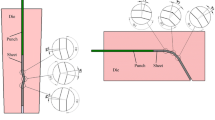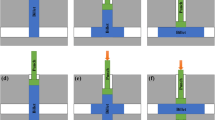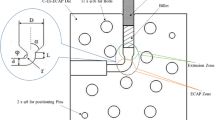Abstract
Equal channel angular pressing (ECAP), expansion equal channel angular pressing (Exp.-ECAP), and hybrid equal channel angular pressing (HECAP) or (Hybrid ECAP) processes were applied to pure copper specimens within this study. After the application of ECAP, the die used in the application of the Exp.-ECAP process was optimized considering the strain inhomogeneity in the specimen and the maximum load that occurred during the process. Finite element method (FEM), artificial neural network (ANN), and genetic algorithm (GA) were utilized together for the optimization process. The optimized die equally minimizes the pressing load and the strain inhomogeneity that occurred in the specimen. Using the optimized die, Exp.-ECAP and HECAP processes were applied to pure copper. The Exp.-ECAP process was previously applied only for aluminum alloys and magnesium alloys. With the application of the Exp.-ECAP process to pure copper, this gap in the literature was removed. In addition, with the application of the HECAP process, the effects of the Exp.-ECAP passes applied after ECAP were also examined which was not done earlier. The specimens, on which ECAP, Exp.-ECAP, and HECAP processes were applied, were subjected to microstructure analysis and mechanical tests, and the effects of these processes were examined. The results obtained showed that the Exp.-ECAP process gave better results in grain refinement and mechanical properties. The Exp.-ECAP passes applied after the ECAP process within the scope of the HECAP process provided a more homogeneous distribution for the microstructure and the hardness.
















Similar content being viewed by others
Data availability
Not applicable.
References
Edalati K, Horita Z (2016) A review on high-pressure torsion (HPT) from 1935 to 1988. Mater Sci Eng A 652:325–352
Nakao Y, Miura H (2011) Nano-grain evolution in austenitic stainless steel during multi-directional forging. Mater Sci Eng A 528:1310–1317. https://doi.org/10.1016/j.msea.2010.10.018
Beygelzimer Y, Prilepo D, Kulagin R, Grishaev V, Abramova O, Varyukhin V, Kulakov M (2011) Planar twist extrusion versus twist extrusion. J Mater Process Technol 211:522–529. https://doi.org/10.1016/j.jmatprotec.2010.11.006
Huang J, Zhu YT, Alexander DJ, Liao X, Lowe TC, Asaro RJ (2004) Development of repetitive corrugation and straightening. Mater Sci Eng A 371:35–39. https://doi.org/10.1016/S0921-5093(03)00114-X
Shaarbaf M, Toroghinejad MR (2008) Nano-grained copper strip produced by accumulative roll bonding process. Mater Sci Eng A 473:28–33. https://doi.org/10.1016/J.MSEA.2007.03.065
Iwahashi Y, Wang J, Horita Z, Nemoto M, Langdon TG (1996) Principle of equal-channel angular pressing for the processing of ultra-fine grained materials. Scr Mater 35:143–146
Özbeyaz K, Kaya H, Kentli A, Şahbaz M, Öğüt S (2019) Mechanical properties and electrical conductivity performance of ECAP processed AA2024 alloy. Indian J Chem Technol 26:266–269
Valiev RZ, Langdon TG (2006) Principles of equal-channel angular pressing as a processing tool for grain refinement. Prog Mater Sci 51:881–981. https://doi.org/10.1016/j.pmatsci.2006.02.003
Faraji G, Mosavi Mashadi M, Kim HS (2011) Tubular channel angular pressing (TCAP) as a novel severe plastic deformation method for cylindrical tubes. Mater Lett 65:3009–3012. https://doi.org/10.1016/j.matlet.2011.06.039
Lipinska M, Chrominski W, Olejnik L, Golinski J, Rosochowski A, Lewandowska M (2017) Ultrafine-grained plates of Al-Mg-Si alloy obtained by incremental equal channel angular pressing: microstructure and mechanical properties. Metall Mater Trans A Phys Metall Mater Sci 48:4871–4882. https://doi.org/10.1007/s11661-017-4258-8
Şahbaz M, Kaya H, Kentli A (2020) A new severe plastic deformation method: thin-walled open channel angular pressing (TWO-CAP). Int J Adv Manuf Technol 106:1487–1496. https://doi.org/10.1007/s00170-019-04748-1
Şahbaz M, Kentli A, Kaya H (2020) Performance of novel TWO-CAP (thin-walled open channel angular pressing) method on AA5083. Met Mater Int
Sepahi-Boroujeni S, Fereshteh-Saniee F (2015) Expansion equal channel angular extrusion, as a novel severe plastic deformation technique. J Mater Sci 50:3908–3919. https://doi.org/10.1007/s10853-015-8937-9
Molodova X, Gottstein G, Winning M, Hellmig RJ (2007) Thermal stability of ECAP processed pure copper. Mater Sci Eng A 460–461:204–213. https://doi.org/10.1016/j.msea.2007.01.042
Wu SD, Wang ZG, Jiang CB, Li GY, Alexandrov IV, Valiev RZ (2003) The formation of PSB-like shear bands in cyclically deformed ultrafine grained copper processed by ECAP. Scr Mater 48:1605–1609. https://doi.org/10.1016/S1359-6462(03)00141-6
Guo T, Wei S, Wang C, Li Q, Jia Z (2019) Texture evolution and strengthening mechanism of single crystal copper during ECAP. Mater Sci Eng A 759:97–104. https://doi.org/10.1016/j.msea.2019.05.042
Han SZ, Goto M, Lim C, Kim CJ, Kim S (2007) Fatigue behavior of nano-grained copper prepared by ECAP. J Alloys Compd 434–435:304–306. https://doi.org/10.1016/j.jallcom.2006.08.179
Stepanov ND, Kuznetsov AV, Salishchev GA, Raab GI, Valiev RZ (2012) Effect of cold rolling on microstructure and mechanical properties of copper subjected to ECAP with various numbers of passes. Mater Sci Eng A 554:105–115. https://doi.org/10.1016/j.msea.2012.06.022
Salimyanfard F, Reza Toroghinejad M, Ashrafizadeh F, Jafari M (2011) EBSD analysis of nano-structured copper processed by ECAP. Mater Sci Eng A 528:5348–5355. https://doi.org/10.1016/j.msea.2011.03.075
Alawadhi MY, Sabbaghianrad S, Huang Y, Langdon TG (2017) Direct influence of recovery behaviour on mechanical properties in oxygen-free copper processed using different SPD techniques: HPT and ECAP. J Mater Res Technol 6:369–377. https://doi.org/10.1016/j.jmrt.2017.05.005
Sepahi-Boroujeni S, Fereshteh-Saniee F (2015) The influences of the expansion equal channel angular extrusion operation on the strength and ductility of AZ80 magnesium alloy. Mater Sci Eng A 636:249–253. https://doi.org/10.1016/j.msea.2015.03.073
Fereshteh-Saniee F, Sepahi-Boroujeni A, Sepahi-Boroujeni S (2016) Optimized tool design for expansion equal channel angular extrusion (Exp-ECAE) process using FE-based neural network and genetic algorithm. Int J Adv Manuf Technol 86:3471–3482. https://doi.org/10.1007/s00170-016-8487-6
Frint S, Hockauf M, Frint P, Wagner MFX (2016) Scaling up Segal’s principle of equal-channel angular pressing. Mater Des 97:502–511. https://doi.org/10.1016/j.matdes.2016.02.067
Kaya H, Uçar M, Cengiz A, Samur R, Özyürek D, Çalişkan A (2014) Novel molding technique for ECAP process and effects on hardness of AA7075. Mechanika 20:5–10. https://doi.org/10.5755/j01.mech.20.1.4207
Kaya H, Uçar M (2016) The effects of mechanical properties on fatigue behavior of ECAPed AA7075. High Temp Mater Process 35:225–234. https://doi.org/10.1515/htmp-2014-0193
Haghdadi N, Zarei-Hanzaki A, Abou-Ras D, Maghsoudi MH, Ghorbani A, Kawasaki M (2014) An investigation into the homogeneity of microstructure, strain pattern and hardness of pure aluminum processed by accumulative back extrusion. Mater Sci Eng A 595:179–187. https://doi.org/10.1016/j.msea.2013.11.077
Öğüt S, Kaya H, Kentli A, Özbeyaz K, Şahbaz M, Uçar M (2021) Investigation of strain inhomogeneity in hexa-ECAP processed AA7075. Arch Metall Mater 66:431–436. https://doi.org/10.24425/amm.2021.135875
Patil Basavaraj V, Chakkingal U, Prasanna Kumar TS (2009) Study of channel angle influence on material flow and strain inhomogeneity in equal channel angular pressing using 3D finite element simulation. J Mater Process Technol 209:89–95. https://doi.org/10.1016/j.jmatprotec.2008.01.031
Amani S, Faraji G, Abrinia K (2017) Microstructure and hardness inhomogeneity of fine-grained AM60 magnesium alloy subjected to cyclic expansion extrusion (CEE). J Manuf Process 28:197–208. https://doi.org/10.1016/j.jmapro.2017.06.007
Chen B, Lu C, Lin D, Zeng X (2014) Microstructural evolution and mechanical properties of Mg 95.5Y3Zn1.5 alloy processed by extrusion and ECAP. Met Mater Int 20:285–290. https://doi.org/10.1007/s12540-014-2025-6
Tao NR, Wang ZB, Tong WP, Sui ML, Lu J, Lu K (2002) An investigation of surface nanocrystallization mechanism in Fe induced by surface mechanical attrition treatment. Acta Mater 50:4603–4616. https://doi.org/10.1016/S1359-6454(02)00310-5
Funding
This work was supported by the Marmara University Scientific Research Project within the project number FEN-A-090217-0045.
Author information
Authors and Affiliations
Contributions
All authors contributed to the study conception and design. Design of experiment was made by Serkan Öğüt and Assoc. Dr. Hasan Kaya. Material preparation, data collection, and analysis were performed by Serkan Öğüt under the supervision of Assoc. Dr. Hasan Kaya, Prof. Dr. Aykut Kentli, and Prof. Dr. Mehmet Uçar. The internal draft of the manuscript was written by Serkan Öğüt and all authors commented on previous versions of the manuscript. Assoc. Dr. Hasan Kaya and Prof. Dr. Aykut Kentli reviewed and edited the internal draft. All authors read and approved the final manuscript.
Corresponding author
Ethics declarations
Ethics approval
Authors acknowledge that this study is original and has not been published elsewhere.
Consent to participate
All authors confirm that they are involved to this study.
Consent for publication
The authors confirm that the manuscript has been read and approved by all named authors.
Competing interests
The authors declare no competing interests.
Additional information
Publisher’s note
Springer Nature remains neutral with regard to jurisdictional claims in published maps and institutional affiliations.
Rights and permissions
About this article
Cite this article
Öğüt, S., Kaya, H., Kentli, A. et al. Applying hybrid equal channel angular pressing (HECAP) to pure copper using optimized Exp.-ECAP die. Int J Adv Manuf Technol 116, 3859–3876 (2021). https://doi.org/10.1007/s00170-021-07717-9
Received:
Accepted:
Published:
Issue Date:
DOI: https://doi.org/10.1007/s00170-021-07717-9




